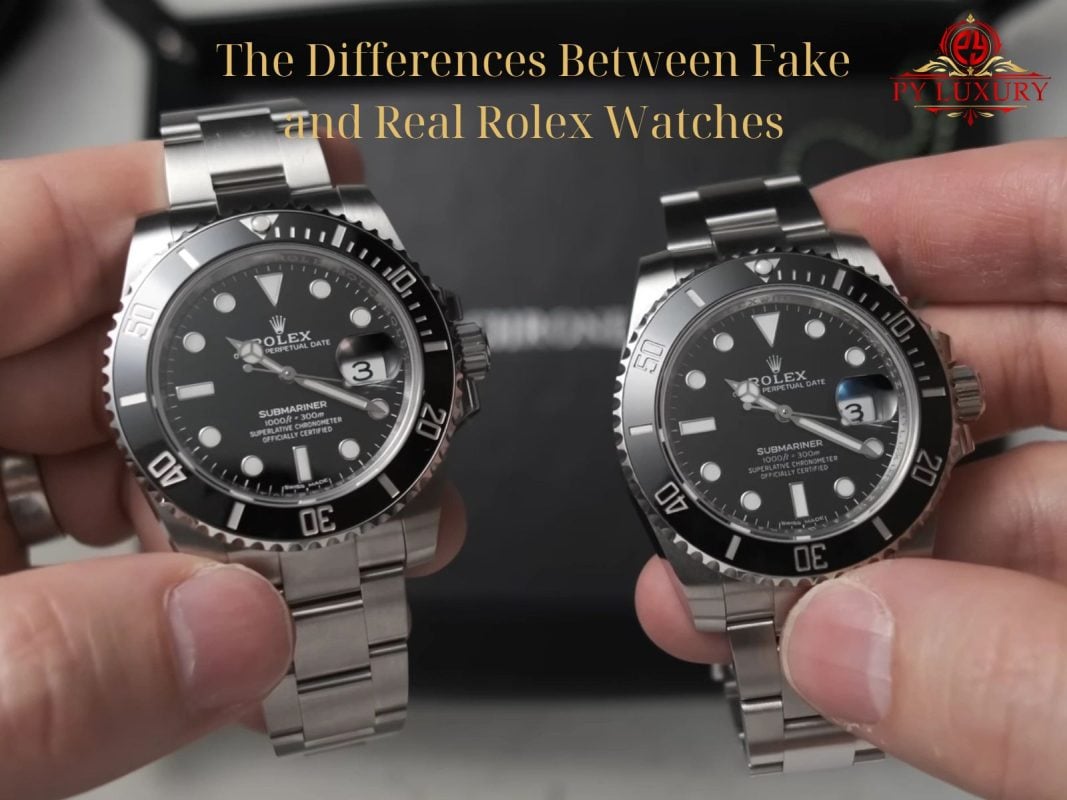Blog about Watches, Jewelry & Bags, Watch Blog
The Differences Between Fake and Real Rolex Watches: A Comprehensive Guide
Did you know there are more fake Rolex watches in the world than real ones? This surprising fact underscores the sheer size of the counterfeit watch market, where imitations range from cheap, easily identifiable fakes to highly sophisticated replicas known as Superclones. While low-quality fakes mislead consumers and tarnish the reputation of the industry, high-end Superclones are crafted for enthusiasts who appreciate luxury designs at a more affordable price.
As a leading vendor of super clone Rolex watches, we take pride in offering quality replicas while condemning poorly made counterfeits. In this comprehensive guide, Py-Luxury will explore the subtle differences between authentic Rolex watches and high-quality replicas, equipping you with the knowledge to make an informed purchase.
How to Tell if a Rolex is Real
Rolex Serial Numbers: A Unique Identifier
One of the simplest ways to check if a Rolex is authentic is by examining its serial number. Every genuine Rolex has a unique serial number, which can provide valuable insights into its authenticity.
- Before 2010: Rolex serial numbers followed a sequential pattern, making it possible to estimate the production date of the watch.
- After 2010: Rolex switched to a randomized system, making it impossible to date a watch based on its serial number.
To check a Rolex serial number:
- Search the serial number in quotation marks on Google (e.g., “Z754008”).
- If the search yields multiple results showing the same number used on different watches or configurations, such as a Submariner black and a Two-Tone, it is most likely a fake.
Important Note:
Not finding any results for a serial number doesn’t automatically confirm that the watch is genuine. Some budget-friendly replica watches may reuse the same serial number across multiple pieces to save costs, whereas high-end Superclones typically produce smaller batches or even assign unique serial numbers to each watch.
Where to Find the Serial Number on a Rolex
The location of the serial number on a Rolex depends on the model’s production year:
- Older Models: The serial number is engraved between the lugs at the 6:00 position, which requires the bracelet to be removed for inspection.
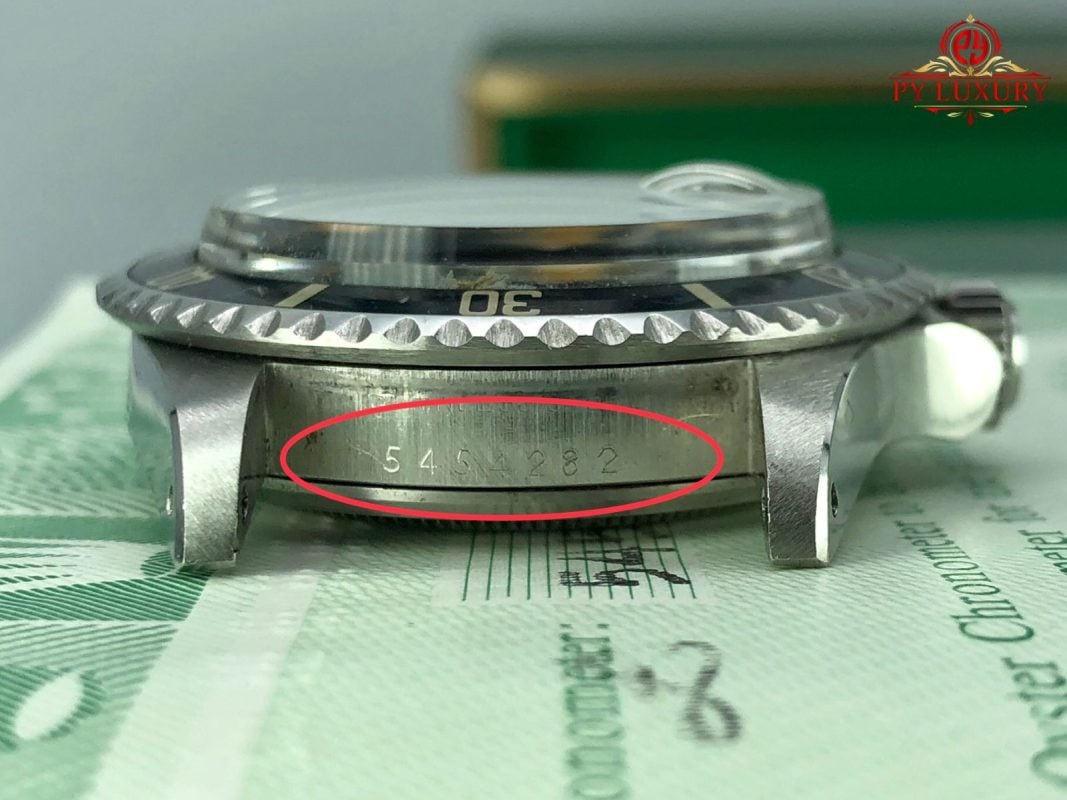
- Modern Models: The serial number is engraved on the rehaut (the inner bezel) at the 6:00 position, making it visible without removing the bracelet.
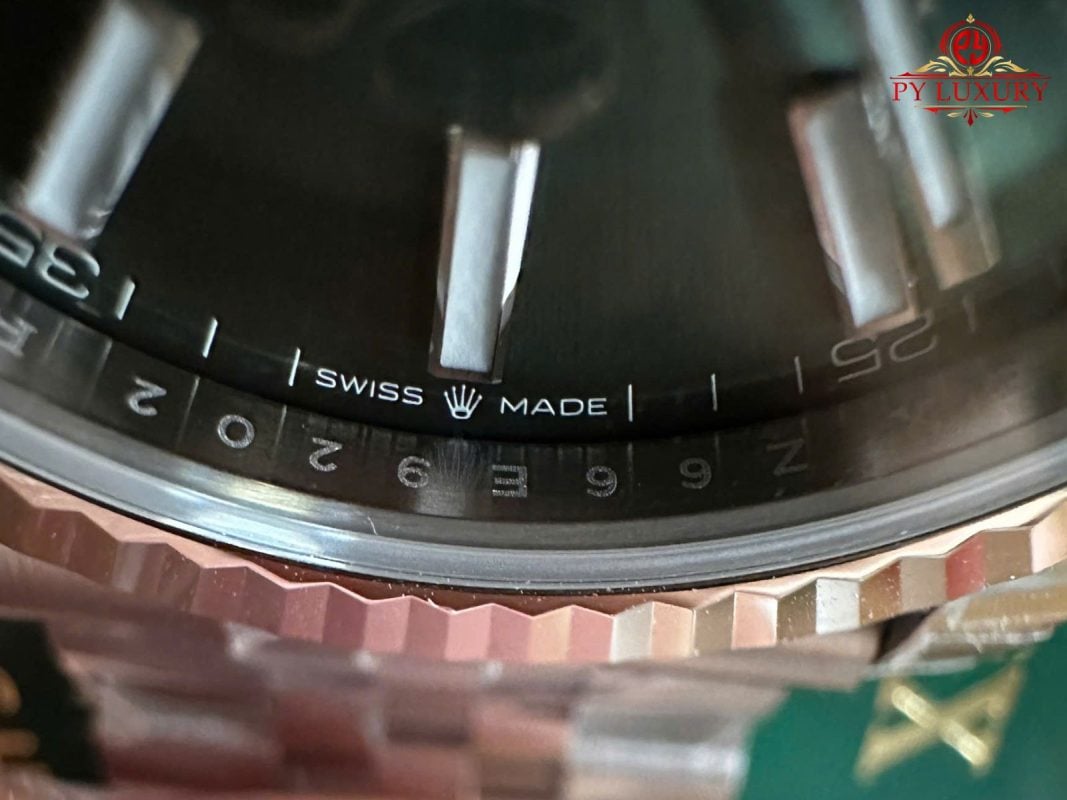
By understanding the significance of Rolex serial numbers and knowing where to locate them, you can take the first step in verifying the authenticity of a Rolex watch.
Read the detailed guide on Bobswatches to have full understanding about Rolex serial numbers with production dates.
Rolex Cyclops Lens and Date Window
The Cyclops lens is one of Rolex’s most recognizable features, designed to magnify the date window for better legibility. This small detail, however, is surprisingly difficult for counterfeiters to replicate with precision.
Key Features of the Rolex Cyclops Lens
- Magnification:
On an authentic Rolex Submariner, the Cyclops lens magnifies the date by 2.5 times, making the numbers clear and easy to read. Lower-end replicas often fail to achieve this level of magnification accurately. - Clarity:
The date under the Cyclops lens on a genuine Rolex appears crisp and distortion-free. Cheaper fakes frequently display blurry, skewed, or distorted numbers, making it easy to spot inconsistencies. - Anti-Reflective Coating:
Rolex uses a clear anti-reflective coating beneath the Cyclops lens, enhancing visibility without altering the natural color of the lens. Many high-quality replicas struggle to replicate this feature, and even advanced Superclones may have a slight tint that becomes noticeable under certain angles or lighting conditions.
Rolex Cyclops: Real vs. Fake
When comparing a real Rolex with a fake, examining the Cyclops lens is a reliable indicator of authenticity. Here’s what to look for:
- Magnification: Check if the date is magnified correctly to 2.5 times. Anything less (or more exaggerated) is a red flag.
- Clarity: Look for any signs of distortion or blurriness in the date display.
- Tint: Slight coloration under the lens in replicas can reveal their true nature.
The Date Font
Even when the Cyclops lens appears well-crafted, the font of the date numbers can be a telling detail:
- On authentic Rolex watches, the font is consistent and flawless.
- Replica watches, even high-end ones, may feature slight discrepancies. For example, the number “3” might have a sharper peak or an irregular curve under detailed magnification.
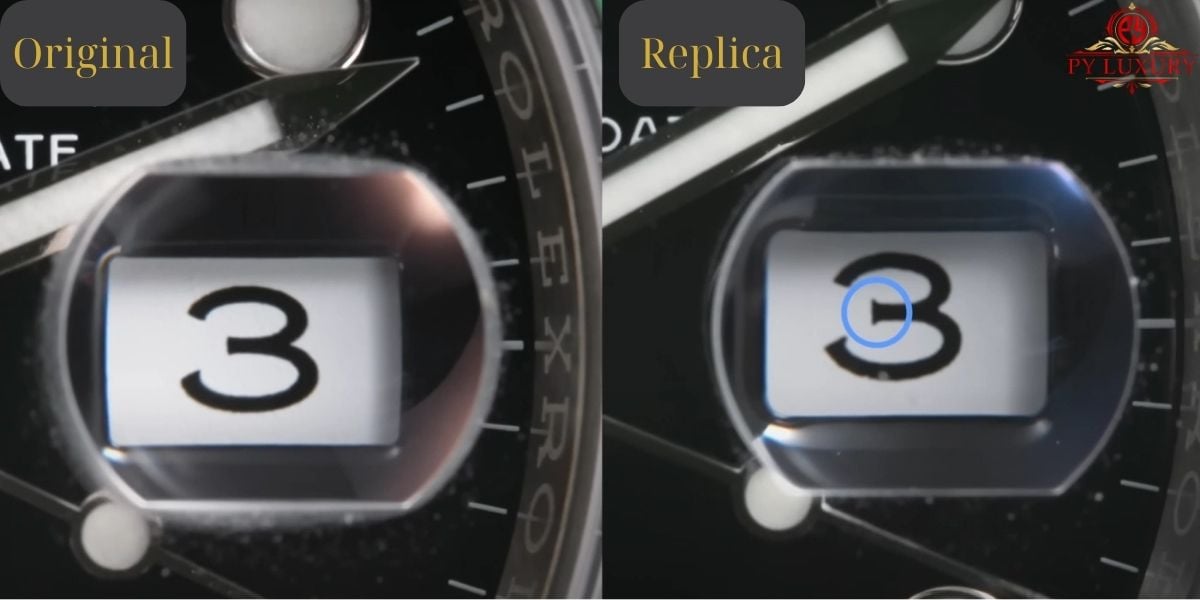
Pro Tip for Verification
To accurately verify the Cyclops lens and date window:
- Compare the watch side by side with a genuine Rolex.
- Use a magnifying glass or jeweler’s loupe to inspect for inconsistencies in magnification, clarity, and font quality.
By paying close attention to the Cyclops lens and date window, you can quickly identify discrepancies that distinguish authentic Rolex watches from even the most sophisticated replicas.
Rolex Laser-Etched Crown
One of the most discreet yet defining features of a genuine Rolex is the laser-etched crown located at the 6 o’clock position on the crystal. This subtle detail, almost invisible to the naked eye, can only be seen under magnification or strong lighting, making it a key indicator of authenticity.
The Craftsmanship of the Laser-Etched Crown
- Precision Detailing:
Rolex employs advanced technology to create the micro-etched crown, using tiny dots at varying heights and depths within the sapphire crystal. Unlike a simple engraved design, these dots form a logo that appears sharp, crisp, and perfectly aligned. - Subtle Visibility:
On an authentic Rolex, the crown is so subtle that it’s nearly imperceptible without a jeweler’s loupe or macro lens. This level of subtlety ensures the watch’s elegance while adding an extra layer of security against counterfeiting.
Rolex Laser-Etched Crown: Real vs. Fake
Replicating the laser-etched crown is one of the most challenging tasks for counterfeit manufacturers, making it a reliable point of distinction:
- Low-Quality Replicas: Often lack the etched crown entirely or replace it with a visibly engraved logo, which is a clear giveaway.
- Mid-Tier and High-End Replicas: May attempt to mimic the crown but frequently over-accentuate its visibility to ensure it’s noticed, deviating from Rolex’s subtle approach.
- Superclones: Achieve a closer resemblance but may still miss the fine depth variations or alignment seen in authentic Rolex watches.
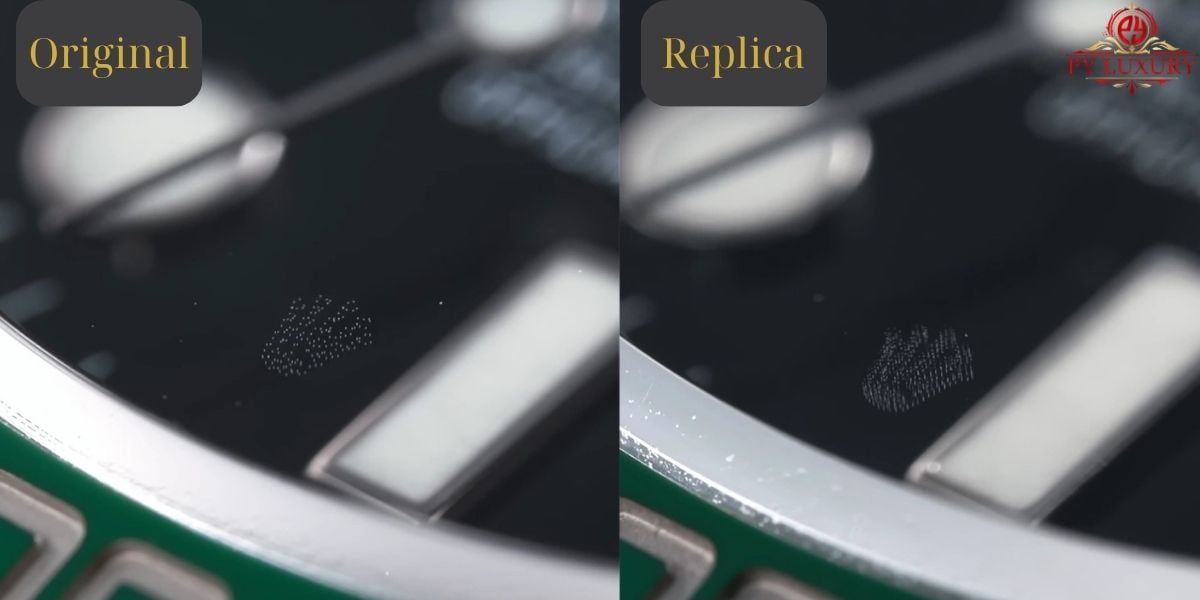
How to Verify the Laser-Etched Crown
The laser-etched crown on a Rolex watch is created using advanced micro-electronic technology, developed in research labs in Geneva. Rolex uses thousands of microscopic laser dots, varying in depth and angle, to create a 3D effect. This not only ensures aesthetic precision but also enhances anti-counterfeiting measures, making it nearly impossible to replicate with standard engraving methods.
To check the authenticity of the etched crown:
- Use Proper Tools: Inspect the area with a jeweler’s loupe, a macro lens, or under strong lighting to reveal the crown’s intricate details.
- Look for Depth and Alignment: Ensure the crown is formed with tiny, layered dots rather than a flat or continuous line. Misalignments or overly prominent logos are common in replicas.
Why the Laser-Etched Crown Matters
This small but significant feature exemplifies Rolex’s commitment to precision and serves as a key defense against counterfeiting. For enthusiasts and collectors, spotting the nuances of the laser-etched crown is a rewarding way to discern genuine craftsmanship from imitation.
By closely examining this detail, you can differentiate between authentic Rolex watches and even the most advanced replicas, reinforcing your confidence in your purchase.
Rolex Rehaut: A Subtle Marker of Authenticity
The rehaut, or inner ring, is a critical yet often overlooked feature of Rolex watches. Located between the dial and the glass or bezel, the rehaut not only adds to the watch’s aesthetic appeal but also serves as an important marker of authenticity. Modern Rolex watches feature the word “Rolex” engraved repeatedly around the rehaut, with specific markers at key positions.
Key Features of the Rolex Rehaut
- Engravings and Alignment:
- At 12 o’clock, the rehaut displays the Rolex crown logo.
- At 6 o’clock, the serial number of the watch is engraved.
- The text “Rolex” is laser-etched around the rehaut, and the engraving is exceptionally precise, sharp, and clean.
- Evolution Over Time:
Rolex introduced rehaut engravings in 2004. Watches manufactured before this year will not feature the engraved rehaut, so its absence on older models is not a cause for concern.
How to Spot Differences Between Authentic and Replica Rehaut
The rehaut is a tricky area for counterfeiters to replicate due to the precision required in its laser engraving and alignment. Here’s what to look for:
1. Quality of Engraving:
- On a genuine Rolex, the laser-etched text is perfectly executed, with sharp and clean edges.
- Replica watches may feature deeper engravings or inconsistent lettering, with uneven spacing or overly dark lines in the middle of the text.
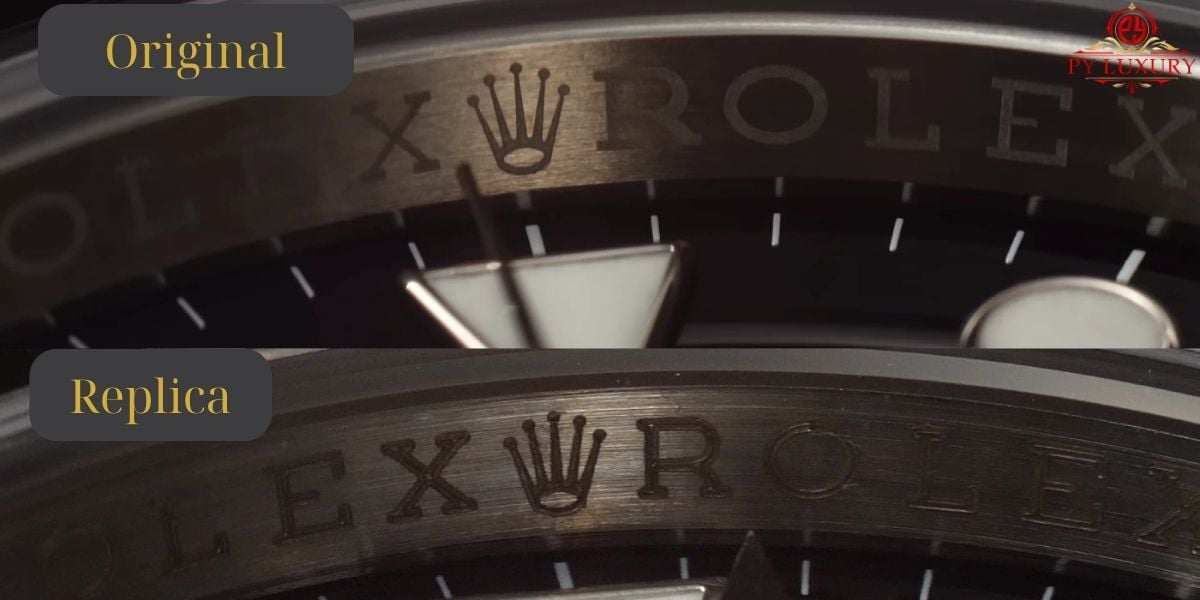
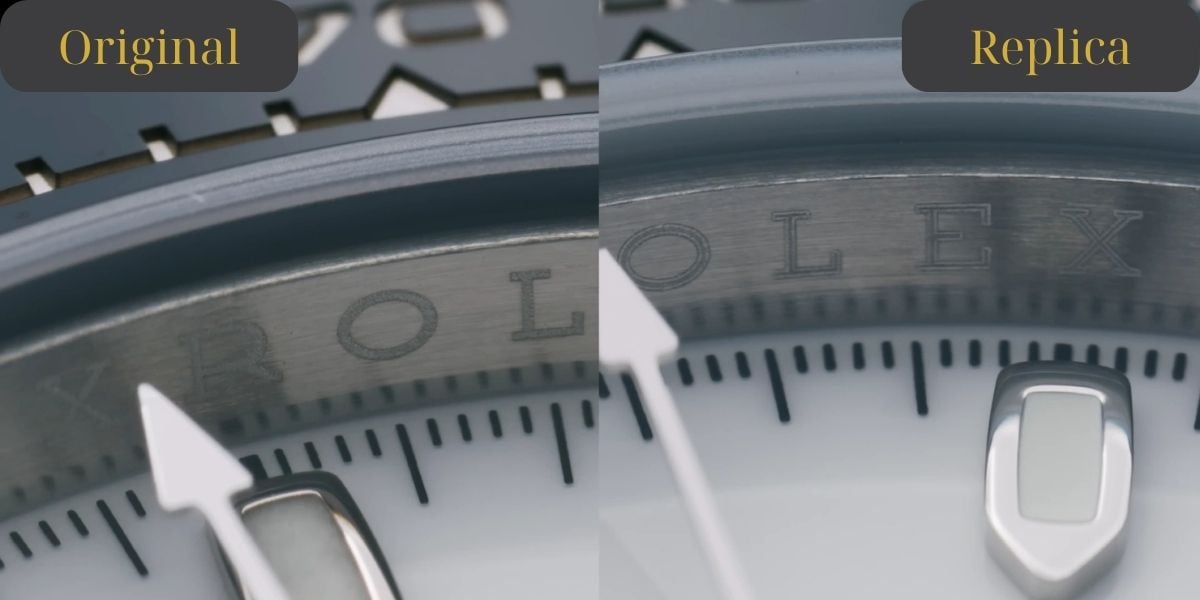
2. Alignment with Hour Markers:
- On the right side of the dial (1 o’clock to 5 o’clock), the “X” in “Rolex” should align perfectly with the hour markers.
- On the left side of the dial (7 o’clock to 11 o’clock), the “R” in “Rolex” should align with the hour markers.
- Even high-quality Superclone replicas can struggle to get this alignment right, with minor deviations that are noticeable under close inspection.
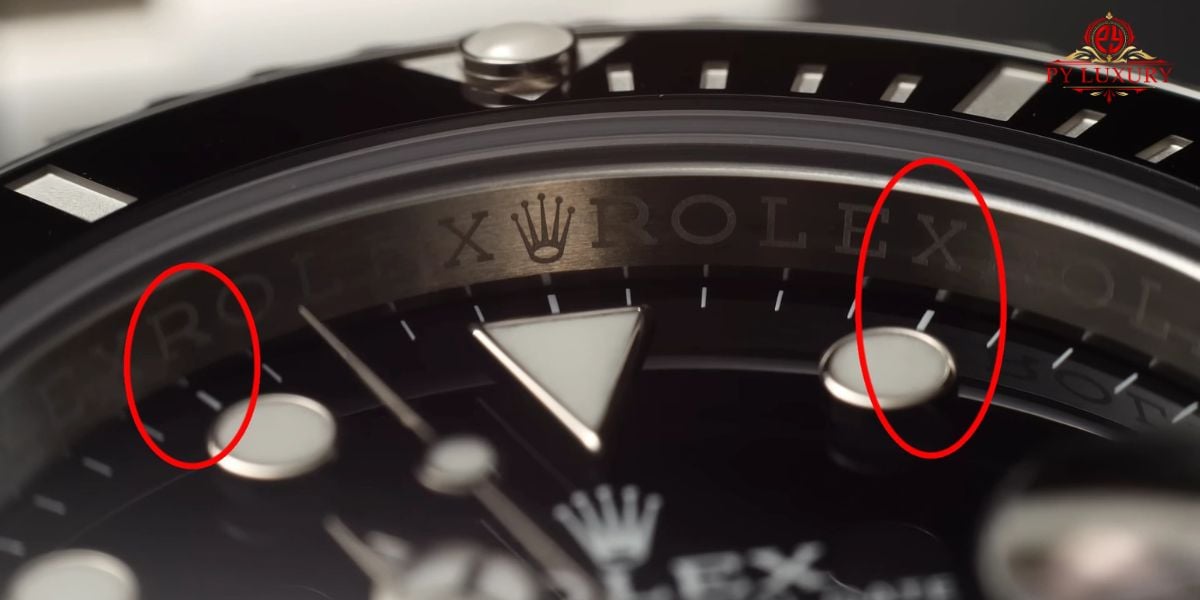
How to Inspect the Rehaut
- Tools Needed: Use an ultra macro lens or a jeweler’s loupe for detailed inspection. A regular magnifying glass will not provide enough clarity to examine the engraving properly.
- Side-by-Side Comparison: If possible, compare the watch with an authentic Rolex to identify inconsistencies in text depth, sharpness, or alignment.
Why the Rehaut Matters
The rehaut engraving reflects Rolex’s meticulous attention to detail and is a subtle yet effective feature in authenticating their watches. For replica watches, achieving the same level of precision remains a significant challenge. By carefully examining the rehaut, you can uncover inconsistencies that separate genuine Rolex watches from even the most advanced replicas.
Understanding the importance of this small yet crucial feature can give you confidence in your ability to distinguish between real and fake Rolex watches.
Rolex Finishing: The Art of Perfection
The finishing on a Rolex watch is a testament to its craftsmanship, with every brushed or polished surface executed to near perfection. From the case to the bracelet, the meticulous attention to detail ensures that each component meets Rolex’s exacting standards. For enthusiasts, this level of finishing is one of the most distinctive features of an authentic Rolex.
Rolex’s Immaculate Finishing
- Brushed Surfaces:
The brushing on models like the Rolex Submariner is extremely fine, creating a uniform texture that reflects light subtly. This level of precision requires significant expertise, especially when working with 904L stainless steel, a material known for its durability and scratch resistance but also its difficulty in machining. - Polished Areas:
Polished surfaces, such as the case edges and links, exhibit a mirror-like shine without blemishes. Rolex achieves this by using specialized polishing techniques that result in flawless transitions between brushed and polished sections.
Superclone Finishing: How Close Do They Get?
High-end Superclone watches have made impressive strides in replicating Rolex finishing. The flanks, links, and overall case finishing of top-tier replicas are virtually indistinguishable from authentic Rolex watches. However, subtle differences remain, particularly in less visible areas:
- Clasp Brushing:
The clasp often reveals discrepancies. On an authentic Rolex, the brushed lines on the clasp are ultra-fine and straight, with consistent spacing. Replicas, even Superclones, may exhibit slightly uneven or thicker lines. These differences are typically visible only under magnification. - Material Challenges:
While Superclones also use 904L steel for added authenticity, the precision required to match Rolex’s exact finish is difficult to achieve consistently.
How to Inspect the Finishing
1. Tools Needed:
Use a magnifying lens or an ultra-macro lens to scrutinize the brushed and polished areas.
2. Comparison:
For the most accurate assessment, compare the replica with an unworn authentic Rolex. A worn authentic watch may show wear and tear, making it harder to identify differences in finishing.
3. Key Areas to Examine:
- Brushed lines on the clasp.
- Transitions between brushed and polished surfaces.
- Uniformity of finishing across links and case edges.
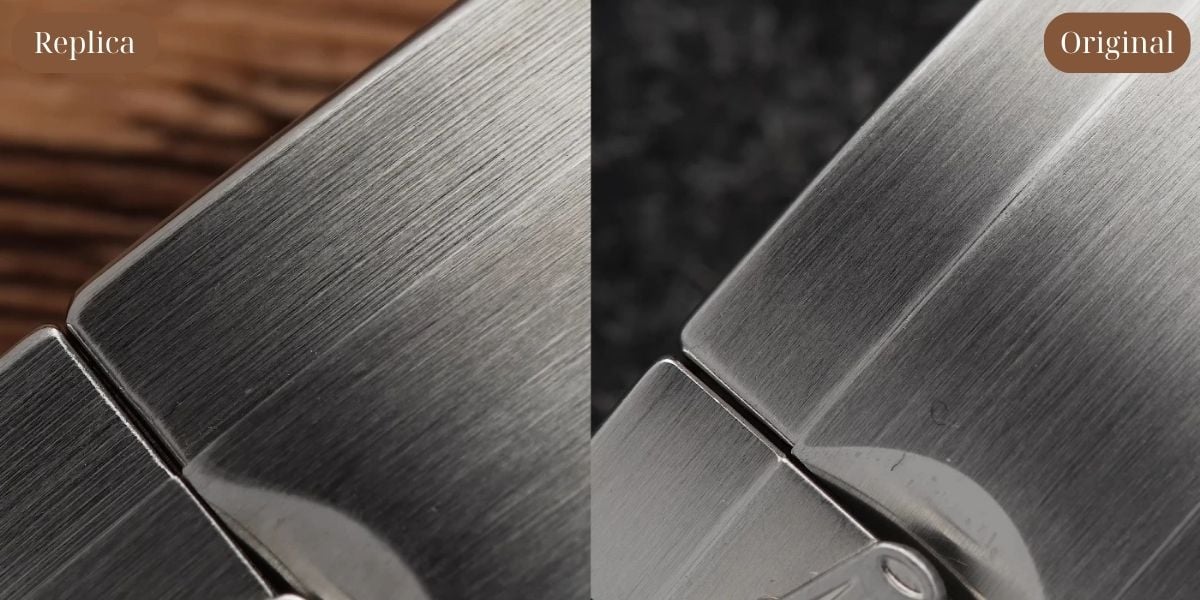
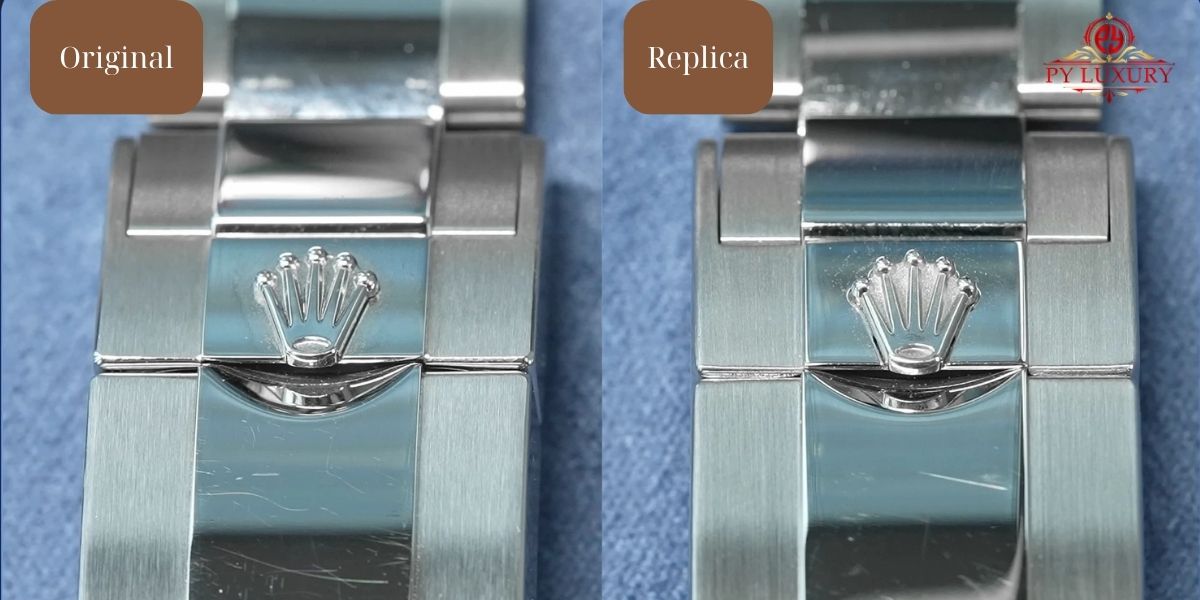
Why Finishing Matters
Rolex finishing is more than just an aesthetic feature; it reflects the brand’s legacy of precision and craftsmanship. While Superclones excel at mimicking the look and feel of genuine Rolex watches, their finishing, especially on intricate details like the clasp, often reveals subtle imperfections that can be used to distinguish them from authentic models.
By closely examining the finishing, collectors and enthusiasts can appreciate the artistry of authentic Rolex watches and identify even the most convincing replicas.
Rolex Movement: A Key Factor in Authenticity and Quality
When evaluating a high-end replica Rolex, it’s essential to consider not only the watch’s external appearance but also its internal mechanism—the movement. Chinese factories have invested heavily in replicating Swiss movements, including ETA and Rolex’s in-house calibers. While these replicas achieve impressive accuracy in some cases, their reliability and precision can vary significantly based on the grade of the replica.
Types of Movements in Replica Rolex Watches
1. Low to Mid-Tier Replicas:
- Movement Used: Japanese Miyota 8205/8215 or the Chinese clone 2813.
- Characteristics: These movements are basic and less precise, with noticeable differences in performance compared to authentic Rolex movements. They are often adorned with a decorated rotor to mimic the look of Rolex’s original mechanism but lack the functionality and craftsmanship of higher-end replicas.
2. High-End Superclones:
- Movement Used: Superclones are powered by more advanced movements, primarily from VR and VS factories. These movements are named to match Rolex’s in-house calibers, such as VR3135 and VR3235, or sometimes use Swiss ETA movements.
- Characteristics: These cloned movements replicate the functions, dimensions, and appearance of authentic Rolex calibers closely, often coming within 90–95% of the original’s performance.
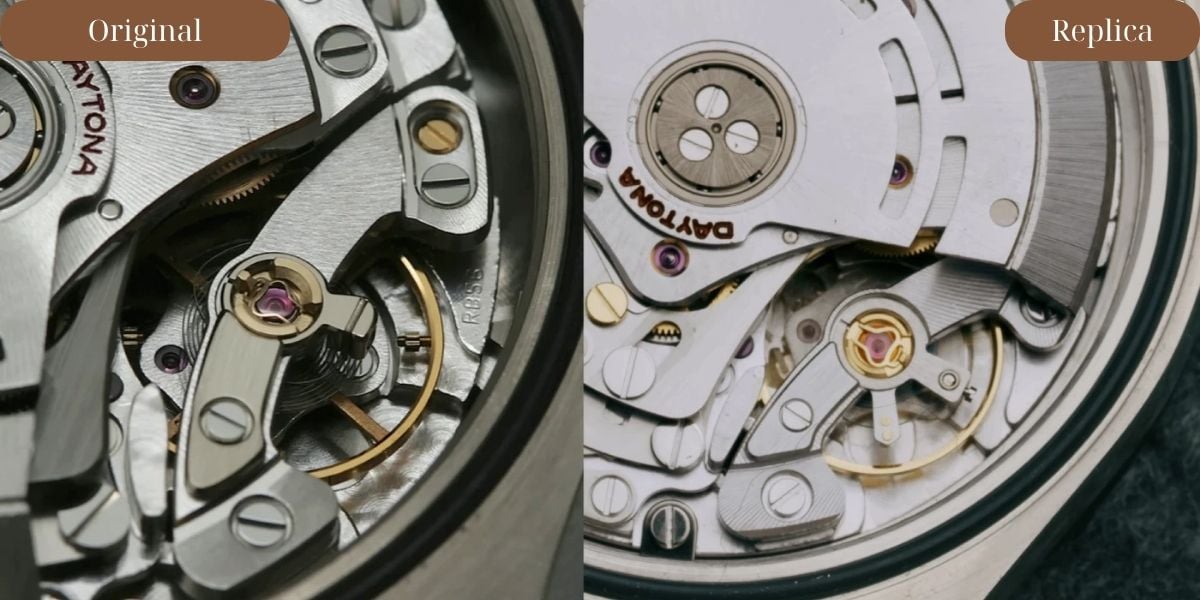
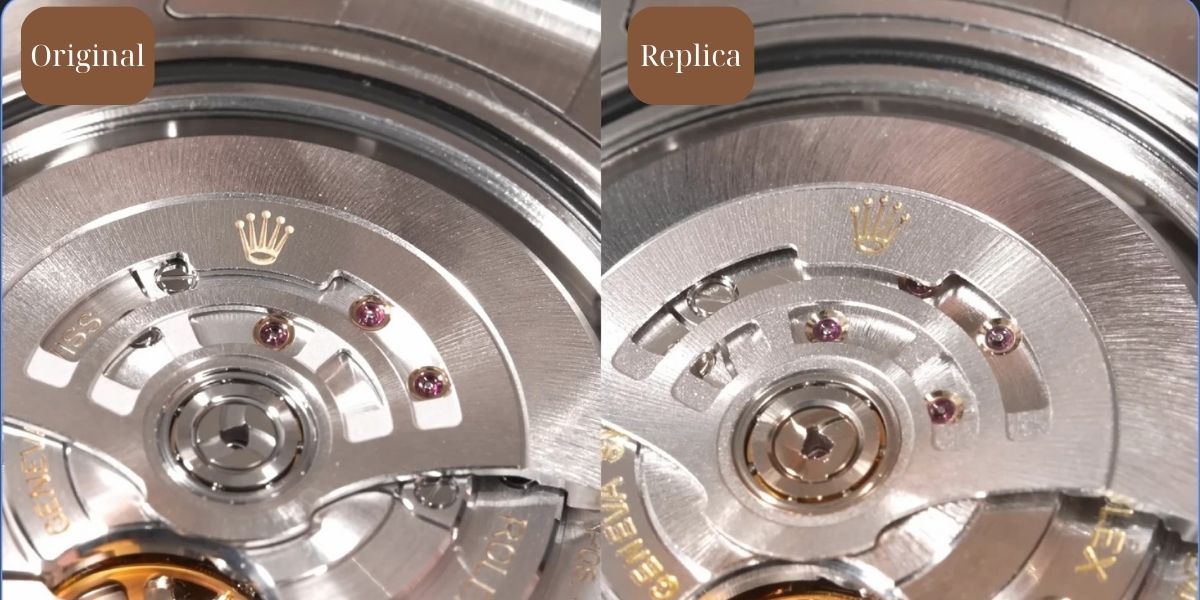
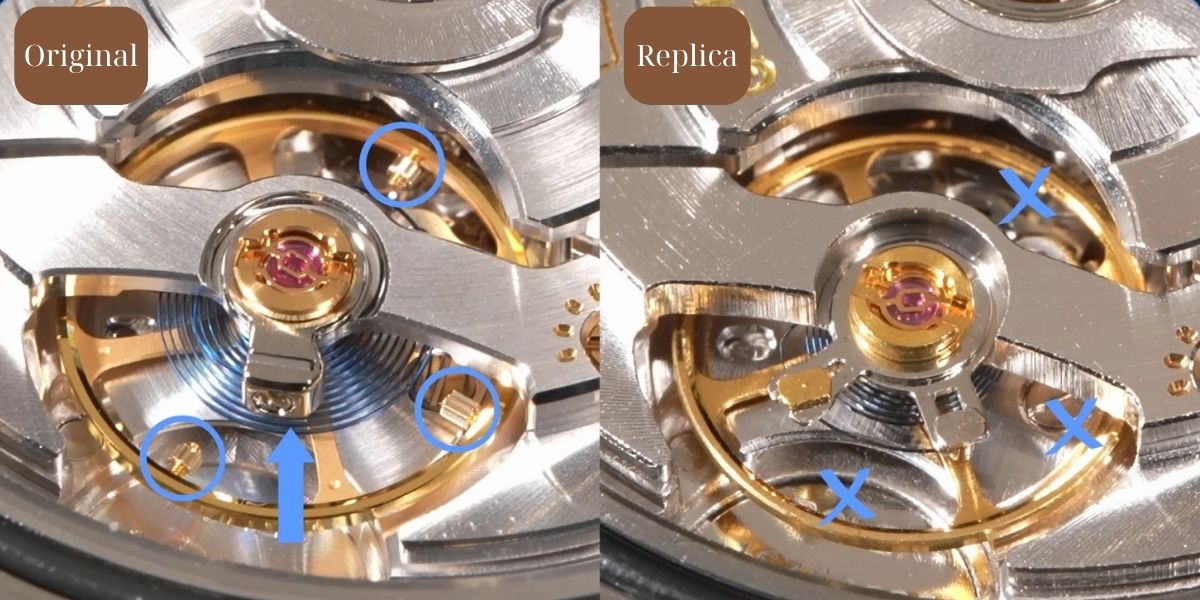
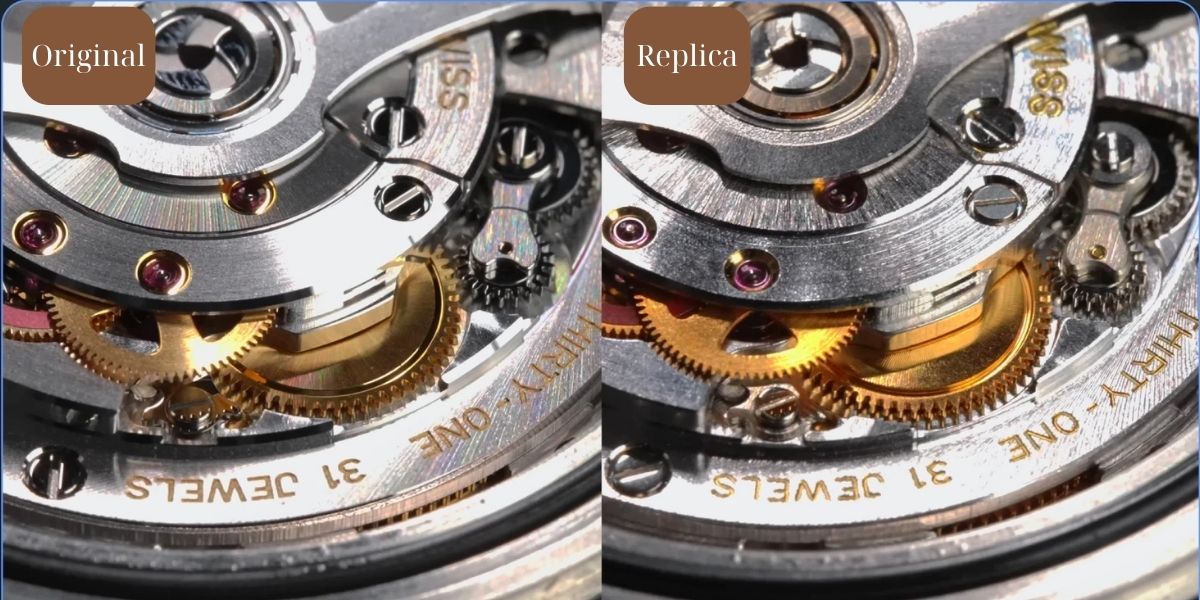
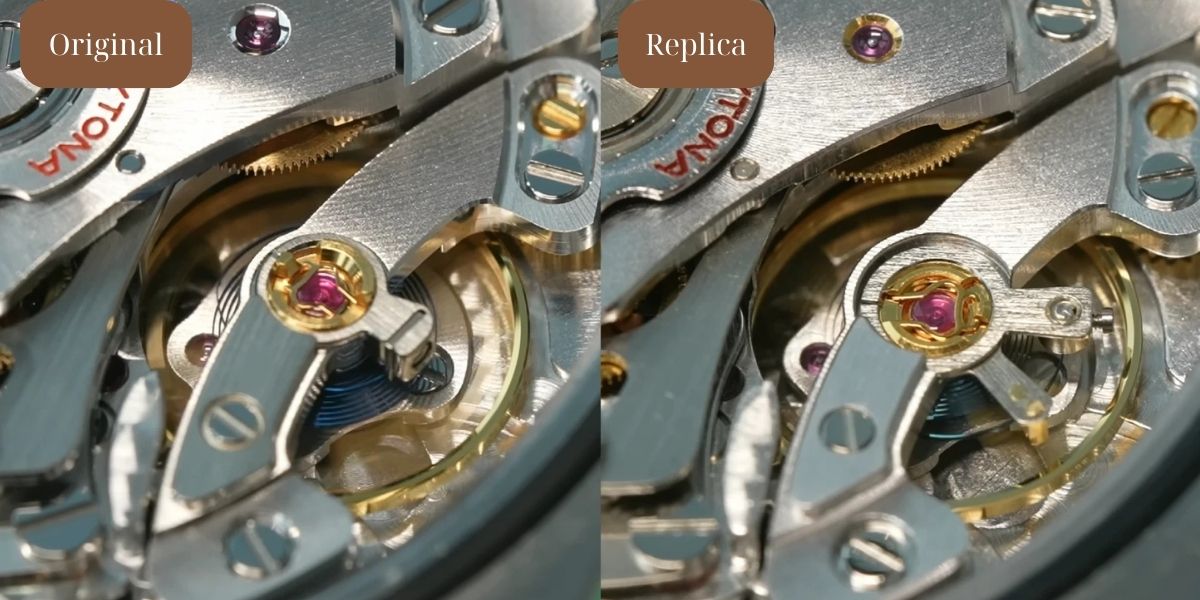
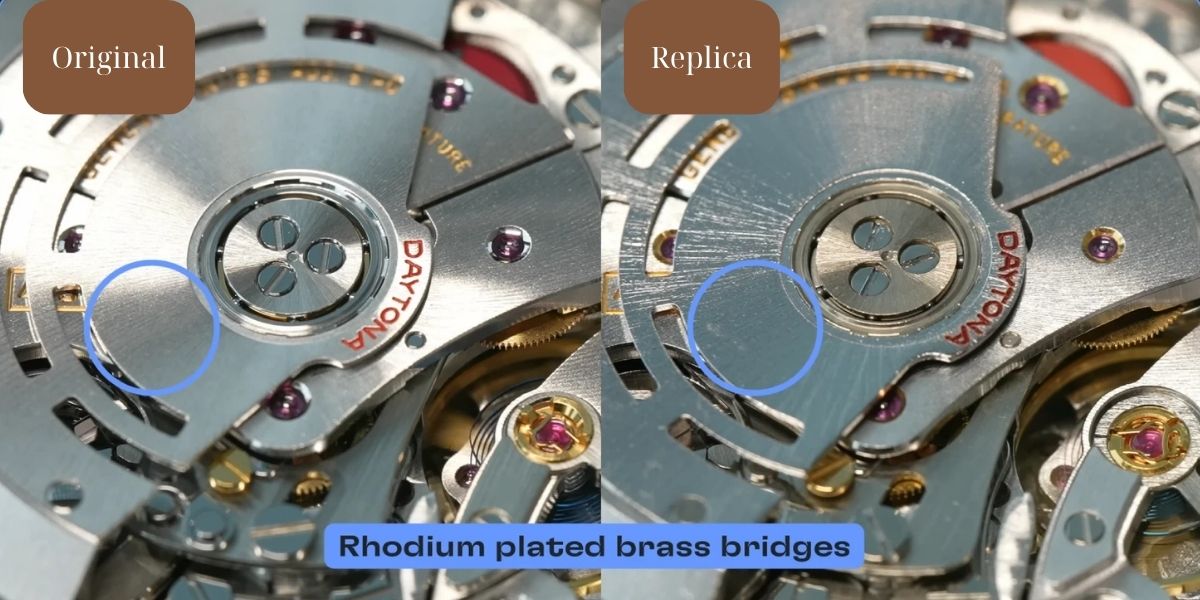
Read our ultimate guide to watch movements found in Rolex replica watches to have deep understanding about replica Rolex watch movements.
The Reality of Replica Movements
Rolex watches are known for their precision and innovation, with in-house movements that are highly reliable and durable. While Superclone movements can mimic the aesthetics and functionality to an impressive degree, there are still some notable differences:
- Finishing: The finishing on authentic Rolex movements is impeccable, with detailed engravings and polished components. Replica movements often fall short in this regard, with less refined finishes visible under close inspection.
- Technical Differences: While Superclone movements are designed to match the specifications of genuine calibers, they may not achieve the same level of accuracy, power reserve, or durability.
Why the Case Back Matters
Most Rolex watches have a closed case back, meaning the movement is not visible without disassembling the watch. This design provides a layer of protection and also makes it harder to scrutinize the movement. While this limits the opportunity for detailed comparisons, it also underscores the importance of purchasing replicas ethically, without attempting to pass them off as authentic.
Important Note:
We strongly discourage selling replica watches as genuine Rolex models. This practice is unethical and illegal. Replica watches are intended for personal enjoyment, offering the aesthetics and functionality of luxury timepieces at a fraction of the cost.
Value of Superclone Movements
Despite their shortcomings, Superclone movements deliver excellent value for the price:
- Affordability: Superclone watches offer 90–95% of the authentic Rolex experience at just 5–10% of the cost.
- Functionality: While minor technical differences exist, these movements are reliable for everyday use and provide a remarkable level of craftsmanship given their price point.
Material Quality: 904L Stainless Steel and Beyond
One of the defining characteristics of an authentic Rolex watch is its use of 904L stainless steel, a premium-grade material renowned for its durability, resistance to corrosion, and exceptional polish. This sets Rolex apart from counterfeit watches, which often use the more common 316L stainless steel.
Why 904L Steel is Superior
- Corrosion Resistance:
According to scientific studies and materials databases like Wikipedia, 904L stainless steel offers superior resistance to localized corrosion compared to 316L. This makes it ideal for maintaining long-lasting quality in various environments, including humid or marine conditions. - Shine and Polish:
904L steel produces a distinctive luster, giving Rolex watches a luxurious appearance that counterfeit watches struggle to replicate. This polished finish also resists scratches better, maintaining its aesthetic appeal over time.
How to Spot the Difference:
- The weight and feel of 904L steel are noticeably more refined than 316L.
- Pay attention to the shine: authentic Rolex watches have a mirror-like polish that replicas often lack.
Clasp Hook: A Subtle Detail
A key feature on newer Submariner models is the clasp hook, which plays an essential role in securing the bracelet. This component is soldered onto the clasp, and Rolex ensures flawless execution in this small but significant detail.
What to Look For:
- Spot Welding:
Authentic Rolex watches exhibit a seamless spot welding surface where the hook is attached. The weld points are evenly spaced, with no discoloration or signs of overheating. - Finish Quality:
Rolex uses precise heat control during soldering to prevent tempering marks, ensuring that the clasp remains perfectly polished and consistent with the rest of the bracelet.
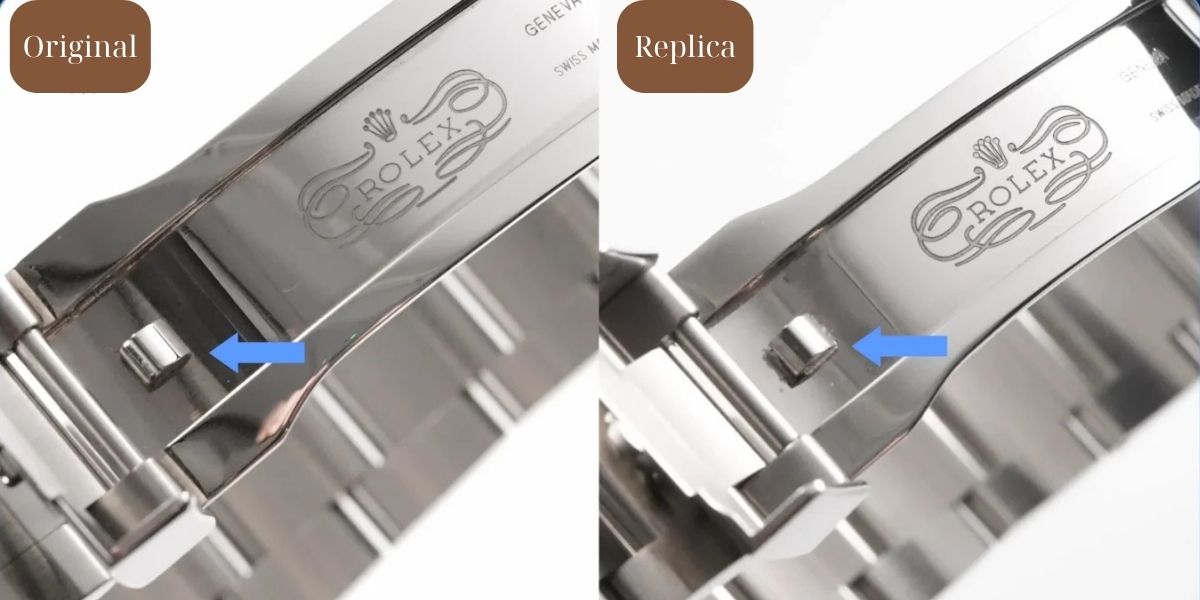
Replica Challenges:
While Superclones achieve impressive results, lower-quality replicas often show uneven welding or discoloration, betraying their authenticity.
Weight and Size: Comparing Real and Fake Rolex Watches
The weight and size of a watch can be a quick way to assess its authenticity, provided you have access to an authentic reference or specifications. Rolex watches are engineered to precise dimensions, contributing to their balanced feel and premium quality.
Real vs. Fake:
- Authentic Rolex: The weight is perfectly distributed, and the size adheres strictly to specifications.
- Superclones: These replicas are often nearly identical in weight and size, making it difficult to distinguish them from authentic watches without professional tools or side-by-side comparisons.
- Lower-Quality Fakes: Typically lighter, with slightly incorrect proportions that can give away their counterfeit nature.
Pro Tip: Slight deviations in weight or size on a Superclone can sometimes be attributed to factors like extra polishing, added links, or post-service adjustments.
Franken Rolex: The Pursuit of Perfection
For those seeking the ultimate replica watch, Franken Rolexes offer an unparalleled level of authenticity. These are custom-built replicas where specific parts—like the dial, bezel, or movement—are replaced with genuine Rolex components.
What Makes a Franken Watch?
- Custom Modifications:
A Franken watch starts with a high-quality replica base (often a Superclone). Genuine Rolex parts are then added to address any noticeable flaws. - Craftsmanship:
Creating a Franken Rolex requires a skilled watchmaker who understands both the replica and authentic components. This craftsmanship ensures seamless integration of the parts.
Challenges with Franken Watches:
- Cost: Franken watches are significantly more expensive than standard replicas due to the cost of sourcing genuine parts.
- Rarity: There are no dedicated Franken Rolex stores because each piece requires an individual assessment, making them a niche option for enthusiasts.
- Detection: Even with these modifications, only highly trained watchmakers or advanced tools can identify a well-made Franken Rolex.
Why Superclones Are Often Enough:
For most enthusiasts, the craftsmanship and quality of high-end Superclones – achieving up to 97% accuracy – are sufficient. The additional 3% achieved by a Franken watch typically appeals only to the most discerning collectors.
Conclusion
In conclusion, navigating the intricate world of Rolex authenticity requires a keen eye and a thorough understanding of the brand’s signature features. From the unique serial numbers and laser-etched crowns to the immaculate finishing and precise movements, Rolex watches are a testament to unparalleled craftsmanship. While high-quality Superclones offer an impressive alternative for enthusiasts seeking luxury at an affordable price, understanding the distinctions between genuine and replica models is key to making an informed purchase. Whether you’re an avid collector or simply an admirer of fine watches, the knowledge gained here empowers you to appreciate the art and science behind each timepiece and make a confident choice tailored to your preferences.
Confidently explore the world of high-quality Replica watches at Py-Luxury. We pride ourselves on offering Superclone timepieces with up to 97% accuracy compared to genuine models. Contact us today for expert advice and a premium shopping experience!

